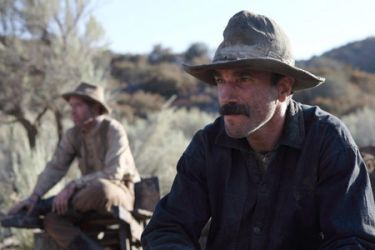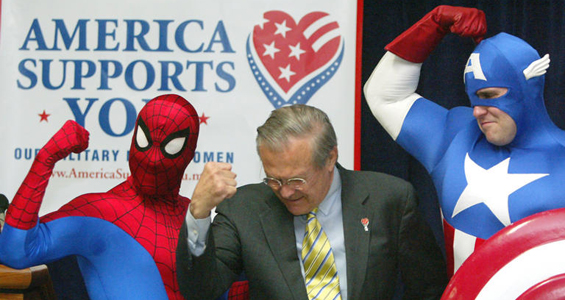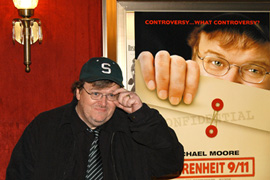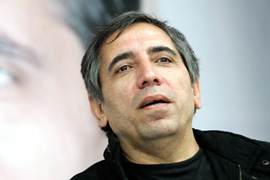A decade in film
It started with the usual blockbuster fanfare but tumultuous world events soon had an impact.

 |
| The flag-waving of the first Spider-Man film disappeared from blockbusters after the Iraq war [AP] |
Out of billions of images beamed across film screens over the past 10 years, two have come to define the decade at large: Spider Man fastened to a gigantic American flag in the very last scene of Sam Raimi’s Spider-Man and a blood-drenched Daniel Day-Lewis resting beside a squashed corpse at the climatic carnage of Paul Thomas Anderson’s There Will Be Blood.
During the five-year gap between the two films, the entire spectrum of cinema would change; the foreboding shadow of 9/11 and the Iraq war would make an undeniable impact on moviemaking worldwide.
Fear, violence and moral ambiguity were the genetic components that shaped the films of the noughties.
This was the decade when Hollywood went dark; the decade that saw Romanian cinema become the toast of the festival circuits, when China and Thailand produced the most feted filmmakers of the new century, when Western European auteurs continued to push the envelope, when Israel put on a human face and when Palestinian cinema came of age.
The Iraq factor
The decade started with the usual fanfare of action blockbusters, star-driven dramas, family films and comedies. The immediate impact of 9/11 would not be felt in the movies until a few years later.
As in every troubled phase in US history, filmgoers would seek escapism in movies.
The unruffled flag-waving glimpsed at the end of Spider-Man would soon subside with the US invasion of Iraq.
From 2003 until the end of the decade, a barrage of films – Clint Eastwood’s Mystic River, Tony Scott’s Man on Fire, Neil Jordan’s The Brave One – re-explored the notion of vengeance and taking the law into one’s hand; themes that have not been probed on such a vast scale since the 1970s.
The graphic images of the Abu Ghraib scandal would inform a new breed of horror films – the Saw and Hostel series’, The Hills Have Eyes – which were labelled “torture porn” and took screen violence to new unforeseen levels of gruesomeness.
In 2007, when the failure of the Iraq invasion began to penetrate broader popular consciousness, a bevy of liberal-minded treatments of the war invaded the cinemas to be met with a humdrum critical and commercial reception.
The ethical indecision and growing aggression induced by the aftermath of the Iraq war reached a new apex with the 2007 double bill of There Will Be Blood and the Coen Brothers’ No Country for Old Men, the two films that fully embodied the spirit of the Bush era.
The dark shade that tainted these films eventually seeped into mainstream cinema.
The biggest franchises of the decade – Star Wars, Batman, Spider-Man, Harry Potter and even James Bond – grew darker with every subsequent installment, infused with a strong element of vengeance.
The revisionist take on heroism was the common thread that linked the defining American films of the decade.
With the 2008 arrival of Christopher Nolan’s The Dark Knight – the highest grossing film of the decade in the US – the death knell of American heroism was finally hammered.
Independents petering out
From a financial standpoint, independent American cinema appeared to be on the verge of being petered out of existence.
Some of the biggest indie powerhouses – Picturehouse, Warner Independent and THINKFilm – collapsed. Miramax, once the most powerful indie studio in the US, slashed its operation by 70 per cent while Paramount Vantage consolidated its activities into its parent studio, Paramount Pictures.
The average cost of a “specialty” production skyrocketed to $49.2mn. The thin line separating independent and studio productions has blurred. With no studio backing, real indie auteurs – Ramin Bahrani (Man Push Cart), Kelly Reichardt (Wendy and Lucy), So Yong Kim (Treeless Mountain) – strived to attract a substantial audience in an overcrowded marketplace.
Perhaps that is why few American auteurs have emerged this decade.
The neo-American realism movement, led by David Gordon Green (George Washington) along with Bahrani, Reichardt, Kim and the duo Anna Boden and Ryan Fleck (Sugar), was one of the few revelations the US has churned out during this decade.
The most prominent new American film figure was Judd Apatow, the director of runaway hits The 40 Year Old Virgin and Knocked Up and producer of innumerable buddy comedies exploring male bonding and regression that came to be dubbed “bromances”.
Artistically, Hollywood reached a new low by the end of the decade, running out of ideas and heavily relying on sequels, remakes, comic-book adaptations and tired formulas.
Despite record-breaking ticket sales, the US film industry has grown safer with every passing year.
Decade of documentaries
 |
| Michael Moore’s Fahrenheit 9/11 is the highest grossing documentary ever [GALLO/GETTY] |
Without a doubt, this has been the decade of nonfiction films.
A profusion of documentaries from across the globe managed, for the first time in history, to cross over from festivals and small art house theatres to the multiplexes.
The key attraction behind the growing popularity of factual film was not just its symbiotic blend between reality and entertainment, but their sense of immediacy.
The US led the charge, fronted by Michael Moore whose Palm d’Or winner Fahrenheit 9/11 became the first, and only, documentary to break the $100mn barrier.
The growing popularity of documentaries and the availability of technology responsible for the hike in their production gradually led to the development of the genre: nature (March of the Penguins, The Cove), character studies (Grizzly Man, The Terror’s Advocate), sports (Tyson, Maradona by Kusturica), food (Super Size Me, Our Daily Bread), economics (I.O.U.S.A., The Corporation) and war (The Fog of War, No End in Sight) among others.
In the second half of the decade, global warming became a hot topic for filmmakers, spawning various investigative pieces in the shape of An Incontinent Truth, The 11th Hour and The Age of Stupid to name a few. The apocalyptic picture these films depicted eventually forced their way into mainstream cinema with WALL•E, 2012 and Avatar.
Beyond Hollywood
Outside Hollywood, the biggest film phenomenon of the decade was the expansion of indigenous markets.
Several nations, including Russia, Turkey, Nigeria and China, witnessed a simultaneous increase in local productions and the construction of new film theatres.
Genre films ruled the global box-office, including in France, the bastion of art house cinema, where a 2008 rural comedy called Bienvenue chez les Ch‘tis became the highest grossing French film in history.
Germany decided to reexamine its past with a slew of period pieces set primarily in the Nazi-era and at the end of communist rule in Eastern Germany. The ensuing works – Downfall, Goodbye Lenin, The Lives of Others – reestablished the entire German film industry.
The success of these films paved the road for the emergence of the present-looking Berlin School directors Christian Petzold, Maren Ade and Thomas Arslan.
Italian cinema enjoyed a momentous revival with the films of Matteo Garrone (Gomorra), Paolo Sorrentino (Il Divo) and the great Nanni Moretti (Palm d’Or winner The Son’s Room).
Spanish cinema remained largely synonymous with Pedro Almodóvar. Major hits from Alejandro Amenábar (The Sea Inside) and Juan Antonio Bayona (The Orphanage) attracted attention to the myriad Spanish talents that are still suppressed under the monopoly of television over film production. José Luis Guerín, Albert Serra and Jaime Rosales, on the other hand, opened the door for a new experimental frontier unseen since the heyday of Luis Buñuel.
With a complete disregard for commercial sensibilities, West European filmmakers continued to dominate festivals. Michael Haneke, Lars von Trier, Claire Denis and the Dardenne brothers delivered some of their greatest works this decade, treating each project as an experiment while constantly challenging the notion of what an art house film should be.
In Asia, Wong Kar-Wai produced one of the biggest sensations of the decade in In the Mood for Love (2000). Takeshi Kitano and Kiyoshi Kurosawa made a radical change of direction, to impressive results, with Dolls and Tokyo Sonata respectively and Hirokazu Kore-eda became a household name with Nobody Knows.
Bollywood’s extending reach
In India, Parallel Cinema continued the resurgence that began at the end of the last century. A number of new filmmakers such as Anurag Kashyap (Black Friday), Rahul Dholakia (Parzania) and Rituparno Ghosh (The Last Lear) broke the Bollywood formula with daring stories deeply steeped in reality.
Bollywood extended its foreign reach, securing permanent slots in theatres across London, the Gulf and New York.
Mainstream films grew in sophistication, aesthetically and generically.
The Mumbai-based industry scored major successes abroad this decade with 2002’s Lagaan, the first Indian film nominated for the Academy Award’s Best Foreign Language Film since Salaam Bombay! in 1989, and 2003’s Devdas, nominee of the best foreign film award at the BAFTA’s.
Unable to penetrate the Indian market, Hollywood – whose market share currently stands at eight per cent – attempted to break into Bollywood from the inside. Sony, Warner Brothers, Walt Disney and 20th Century Fox have all set up branches for producing local pictures.
Although their first productions did not fare well at the box-office, Hollywood remains adamant about capitalising on one of the fastest-growing markets in the world.
The impact of 9/11 did not escape the rest of the world. Terrorism, the mounting anti-American sentiment, assimilation, and racism delineated numerous productions from Western-Europe, South Asia and the Muslim world. Multi-narrative dramas, popularised by Amores perros and Babel director Alejandro González Iñárritu, became the staple genre where these themes flowered.
The new world
The most interesting films of the decade came from the unlikeliest of places.
Thailand’s Apichatpong Weerasethakul took the art world by storm with his structuralist masterworks Tropical Malady and Syndromes and a Century; Argentina’s Lucrecia Martel (The Holy Girl, The Headless Woman) divided critics with her elusive treatises on class distinction; while Mexico’s enfant terrible Carlos Reygadas confounded expectations with his naturalistic mediation on spiritual transcendence in Silent Light.
Few other filmmakers have left a bigger impact on world cinema this decade than China’s Jia Zhangke (Platform, The World, Still Life). His contemplative ruminations on the extermination of traditional cultures under the forces of globalisation and industrialisation presented a face of China that had never been seen before. His indiscernible mélange between documentary footage and fiction narrative has been one of the cinematic landmarks of the new century.
The major discovery of the decade was the new Romanian cinema. Adopting the visual economy of Soviet-era films supplemented with black humour and a critical eye for the oppressive Ceausescu era and the corrupted reality of present bureaucracy, the small-budgeted films of Cristi Puiu (The Death of Mr. Lazarescu), Corneliu Porumboiu (12:08 East of Bucharest), Cristian Nemescu (California Dreamin’) and Cristian Mungiu (Palm d’Or winner 4 Months, 3 Weeks and 2 Days) elevated Romanian film to the forefront of great world cinemas.
Emerging Middle East
 |
| Iranian cinema suffered as directors such as Mohsen Makhmalbaf left [GALLO/GETTY] |
After years of relative obscurity, Middle Eastern cinema finally emerged this decade.
Stuck for decades in a state of infancy, Arab cinema succeeded in gaining international recognition with remarkably diverse works from Lebanon (Nadine Labaki’s Caramel), Morocco (Nabil Ayouch’s Ali Zaoua) and Egypt (Marwan Hamed’s The Yacoubian Building).
Meanwhile, Iranian cinema, the most prominent film industry in the region, took a major blow this decade with the election of Mahmoud Ahmadinejad as president in 2005.
The new ultra conservative administration clamped down on copious productions, imposing strict restrictions on serious films that continued to be celebrated abroad but found little success at home. Comedies and family dramas kept the industry afloat, but several auteurs struggled to produce their films.
The two biggest casualties of the new regime were revered filmmaker Mohsen Makhmalbaf – director of Kandahar, one of the best Iranian films of the decade – who moved to Paris shortly after Ahmadinejad took power.
The second was Bahman Ghobadi, one of the leading figures of the Iranian new wave, who was forced into exile this year following the debut of his controversial fifth feature Nobody Knows about Persian Cats in Cannes.
The situation grew dourer when the Iranian authorities announced last month that directors and actors making unauthorised films “will be punished”.
Various exceptional works from Iran still managed to see the light of day, such as Jafar Panahi’s The Circle and Crimson Gold, Ghobadi’s A Time for Drunken Horses and Turtles Can Fly, Abbas Kiarostami’s Ten and Asghar Farhadi’s About Elly.
Israeli and Palestinian cinema
One of the most notable breakthroughs of the decade was the concurrent rise of Israeli and Palestinian cinemas.
A line of raw, anti-war pictures (Joseph Cedar’s Beaufort, Ari Folman’s Waltz with Bashir) and social dramas (Eran Kolirin’s The Band’s Visit, Eran Riklis’s Lemon Tree) distinguished for their cinematic innovations and technical dexterity put Israel for the first time on the map.
In 2009, Samuel Maoz earned Israel its first major international prize with the Venice Film Festival’s Golden Lion winner Lebanon.
The sympathetic treatment of Arabs and Palestinians and the reproachful view of Israeli politics have led to a wider acceptance of Israeli films in Europe. Arab media and filmmakers remained sceptical though, accusing Israeli filmmakers of distorting facts and not owning up to their state’s crimes.
Against all odds, Palestinian cinema has officially matured over the past 10 years, steering clear of didacticism and self-pity without undermining the Palestinian cause.
Its themes grew more diverse, its approaches more subtle. The examples are aplenty: Elia Suleiman’s Divine Intervention and The Time That Remains, Hany Abu-Assad’s Ford Transit and Paradise Now, Rashid Mashawari’s Ticket to Jerusalem and Laila’s Birthday, and Michel Khleifi’s Zindeeq.
Recent films by new directors Cherien Dabis and Najwa Najjar point towards the promising things to come.